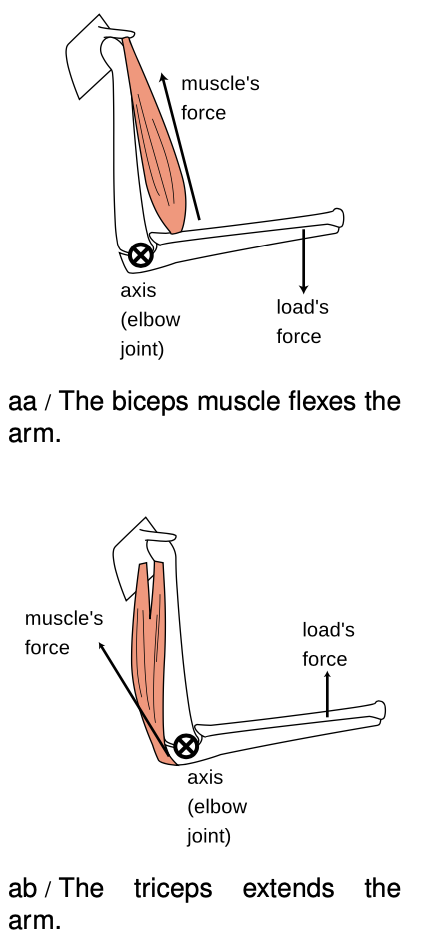LM 15.6 Simple Machines: the lever Collection
15.6 Simple Machines by Benjamin Crowell, Light and Matter licensed under the Creative Commons Attribution-ShareAlike license.
15.6 Simple Machines: the lever
Although we have discussed some simple machines such as the pulley, without the concept of torque we were not yet ready to address the lever, which is the machine nature used in designing living things, almost to the exclusion of all others. (We can speculate what life on our planet might have been like if living things had evolved wheels, gears, pulleys, and screws.) The figures show two examples of levers within your arm. Different muscles are used to flex and extend the arm, because muscles work only by contraction.
Analyzing example a physically, there are two forces that do work. When we lift a load with our biceps muscle, the muscle does positive work, because it brings the bone in the forearm in the direction it is moving. The load's force on the arm does negative work, because the arm moves in the direction opposite to the load's force. This makes sense,  because we expect our arm to do positive work on the load, so the load must do an equal amount of negative work on the arm. (If the biceps was lowering a load, the signs of the works would be reversed. Any muscle is capable of doing either positive or negative work.)
because we expect our arm to do positive work on the load, so the load must do an equal amount of negative work on the arm. (If the biceps was lowering a load, the signs of the works would be reversed. Any muscle is capable of doing either positive or negative work.)
There is also a third force on the forearm: the force of the upper arm's bone exerted on the forearm at the elbow joint (not shown with an arrow in the figure). This force does no work, because the elbow joint is not moving.
Because the elbow joint is motionless, it is natural to define our torques using the joint as the axis. The situation now becomes quite simple, because the upper arm bone's force exerted at the elbow neither does work nor creates a torque. We can ignore it completely. In any lever there is such a point, called the fulcrum.
If we restrict ourselves to the case in which the forearm rotates with constant angular momentum, then we know that the total torque on the forearm is zero,
τmuscle+τload=0τmuscle+τload=0.
If we choose to represent counterclockwise torques as positive, then the muscle's torque is positive, and the load's is negative. In terms of their absolute values,
|τmuscle|=|τload||τmuscle|=|τload|.
Assuming for simplicity that both forces act at angles of 90° with respect to the lines connecting the axis to the points at which they act, the absolute values of the torques are
rmuscleFmuscle=rloadFarmrmuscleFmuscle=rloadFarm
where rmusclermuscle, the distance from the elbow joint to the biceps' point of insertion on the forearm, is only a few cm, while rloadrload might be 30 cm or so. The force exerted by the muscle must therefore be about ten times the force exerted by the load. We thus see that this lever is a force reducer. In general, a lever may be used either to increase or to reduce a force.
Why did our arms evolve so as to reduce force? In general, your body is built for compactness and maximum speed of motion rather than maximum force. This is the main anatomical difference between us and the Neanderthals (their brains covered the same range of sizes as those of modern humans), and it seems to have worked for us.
As with all machines, the lever is incapable of changing the amount of mechanical work we can do. A lever that increases force will always reduce motion, and vice versa, leaving the amount of work unchanged.
It is worth noting how simple and yet how powerful this analysis was. It was simple because we were well prepared with the concepts of torque and mechanical work. In anatomy textbooks, whose readers are assumed not to know physics, there is usually a long and complicated discussion of the different types of levers. For example, the biceps lever, a, would be classified as a class III lever, since it has the fulcrum and load on the ends and the muscle's force acting in the middle. The triceps, ab, is called a class I lever, because the load and muscle's force are on the ends and the fulcrum is in the middle. How tiresome! With a firm grasp of the concept of torque, we realize that all such examples can be analyzed in much the same way. Physics is at its best when it lets us understand many apparently complicated phenomena in terms of a few simple yet powerful concepts.
15.6 Simple Machines by Benjamin Crowell, Light and Matter licensed under the Creative Commons Attribution-ShareAlike license.
Calculators and Collections
- Comments
- Attachments
- Stats
No comments |
